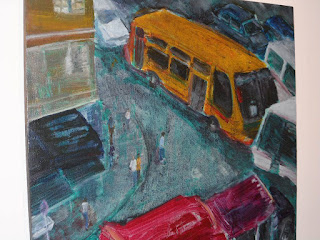FOR SCHOOLS- Virtual or REAL FIELD TRIPS TO COLOMBIA
Two of the five South American Ecological Biodiversity Hotspots are in Colombia.
Choco-Magdalena and Andean Tropical... Read about them here..
Choco-Magdalena and Andean Tropical... Read about them here..
Top 5 Biodiversity Hotspots in South America
According to Conservation International, they are the Atlantic Forest, the Cerrado (both located in Brazil), the Chilean Winter Rainfall-Valdivian Forests , the Tumbes-Chocó-Magdalena corridor, and the Tropical Andes from Venezuela to northern Chile and Argentina.
Unbelievably, the Tropical Andes region contains about a sixth of all plant life in less than 1 percent of the world's land area. A truly staggering statistic. It spans 1,542,644 km², from western Venezuela to northern Chile and Argentina, and includes large portions of Colombia, Ecuador, Peru, and Bolivia.
A virtual continental island bounded by the Pacific Ocean, the Andes Mountains, and the Atacama Desert, theChilean Winter Rainfall-Valdivian Forests harbours richly endemic flora and fauna. The hotspot covers 397,142 km² of the central-northern part of the nation of Chile and the far western edge of Argentina, stretching from the Pacific coast to the crest of the Andean mountains. The hotspot encompasses about 40 percent of Chile's land area
Reaching from the most southeastern portion of Mesoamerica to the northwestern corner of South America, theTumbes-Chocó-Magdalena Hotspot extends for 1,500 kilometers and encompasses 274,597 km² along the western coastal flank of the Andes mountains.
The Atlantic Forest or Mata Atlântica stretches along Brazil's Atlantic coast, from the northern state of Rio Grande do Norte south to Rio Grande do Sul. It extends inland to eastern Paraguay and the province of Misiones in northeastern Argentina, and narrowly along the coast into Uruguay.
The Cerrado spreads across 2,031,990 km² of the central Brazilian Plateau. The most extensive woodland/savanna region in South America, the Cerrado is also the only hotspot that consists largely of savanna, woodland/savanna and dry forest ecosystems. Within the region, there is a mosaic of different vegetation types, including tree and scrub savanna, grassland with scattered trees, and occasional patches of a dry, closed canopy forest called the cerradão.
Find out more about these hotspots here:
http://www.biodiversityhotspots.org/xp/Hotspots/hotspots_by_region/Pages/default.aspx
++++++++++++++++++++++++
MEDELLIN BOASTS PARQUE ARVI ECOPARK
Reachable via METROCABLE from downtown Medellin skimming the treetops, this grand eco park is personned by college age guides. The biodiversity is astounding as are the views of the city, the forests, ...all with a restaurant and artesan shopping!
READ the webpage and look at the attendnt videos and slide presentations. Good for classroom presentation.
http://www.parquearvi.org/
IN DOWNTOWN MEDELLIN,
===We have our own BRAND NEW STATE OFTHE ART
---AQUARIUM both fresh and salt water with guide and hands on programs.
Our Water Museum technology unlike and more advanced than anything in the US museums I've seen--- everything form origins in space to trash in the river, all given hands on and with state of the art computer modeling and demonstrations. Jungle exhibits are especially lovely and interesting.
Our Physics PARQUE EXPLORA- hands on physics- with visiting exhibits in co-operation with the American Museum of Natural history in NYC.
The new DOME and 360 degree theater Planetarium with hands on astrophysics demonstrations, theater presentations.
THe ZOOLOGICO.. the zoo featuring South America macrofauna, jaguars, tapirs, herpetology, monkeys galore and all built on the grounds of one of the most beautiful original haciendas donated to the Zoo.
and the Jardin Botanico, world famous orchid and amazona exhibits, architecturally astounding "canopy" sheltering the orchideum from the sun.
-- Five world class art museums, Botero, Eladio Velez, Ne...l Gomez, pre-Columbian gold and artifacts.
And OUTTA TOWN
The Coffee Triangle, Parque Panaca, a combo show and amusement venue made especially to acquaint city kids with rural ecology, farming, animal husbandry; and the Coffee Park showing off the industry and many other day frips and extended trips to the Amazon, the Caribbean, the Pacific Coast, the Ecuadorean volcanoes, ...
http://www.biodiversityhotspots.org/xp/Hotspots/hotspots_by_region/Pages/default.aspx
++++++++++++++++++++++++
MEDELLIN BOASTS PARQUE ARVI ECOPARK
Reachable via METROCABLE from downtown Medellin skimming the treetops, this grand eco park is personned by college age guides. The biodiversity is astounding as are the views of the city, the forests, ...all with a restaurant and artesan shopping!
READ the webpage and look at the attendnt videos and slide presentations. Good for classroom presentation.
http://www.parquearvi.org/
IN DOWNTOWN MEDELLIN,
===We have our own BRAND NEW STATE OFTHE ART
---AQUARIUM both fresh and salt water with guide and hands on programs.
Our Water Museum technology unlike and more advanced than anything in the US museums I've seen--- everything form origins in space to trash in the river, all given hands on and with state of the art computer modeling and demonstrations. Jungle exhibits are especially lovely and interesting.
Our Physics PARQUE EXPLORA- hands on physics- with visiting exhibits in co-operation with the American Museum of Natural history in NYC.
The new DOME and 360 degree theater Planetarium with hands on astrophysics demonstrations, theater presentations.
THe ZOOLOGICO.. the zoo featuring South America macrofauna, jaguars, tapirs, herpetology, monkeys galore and all built on the grounds of one of the most beautiful original haciendas donated to the Zoo.
and the Jardin Botanico, world famous orchid and amazona exhibits, architecturally astounding "canopy" sheltering the orchideum from the sun.
-- Five world class art museums, Botero, Eladio Velez, Ne...l Gomez, pre-Columbian gold and artifacts.
And OUTTA TOWN
The Coffee Triangle, Parque Panaca, a combo show and amusement venue made especially to acquaint city kids with rural ecology, farming, animal husbandry; and the Coffee Park showing off the industry and many other day frips and extended trips to the Amazon, the Caribbean, the Pacific Coast, the Ecuadorean volcanoes, ...


Comments
Post a Comment